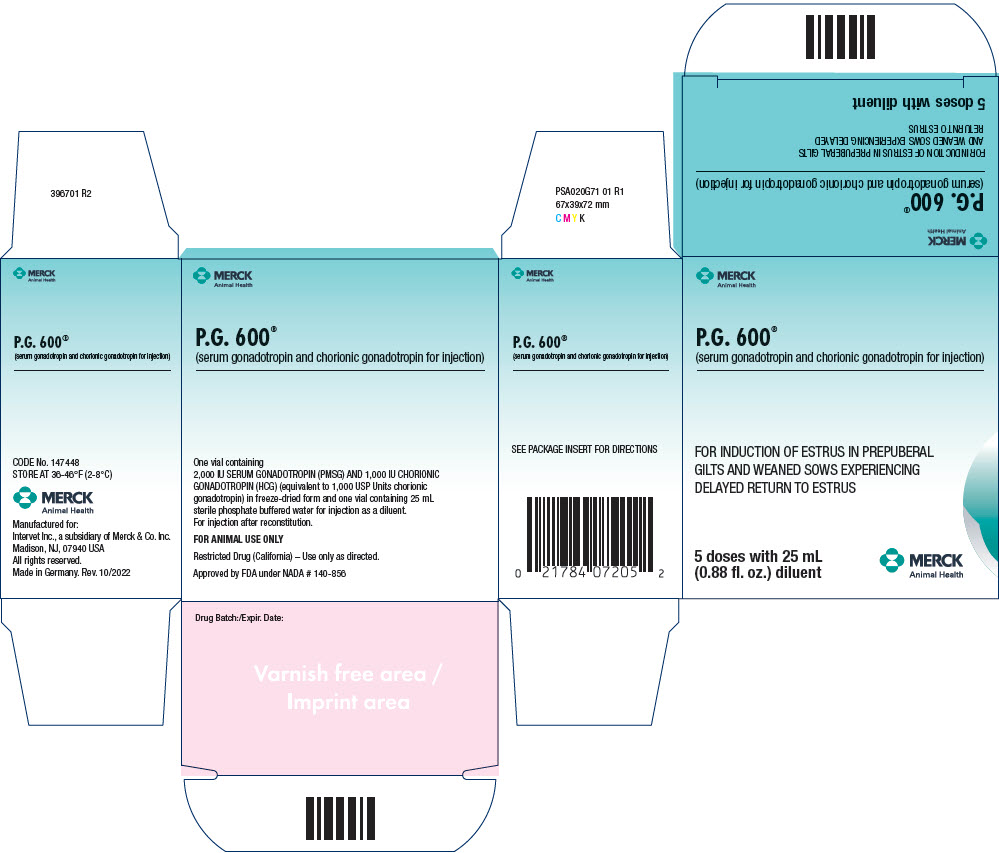FDA records indicate that there are no current recalls for this drug.
Are you a medical professional?
Trending Topics
P.g. 600 Recall
Get an alert when a recall is issued.
Questions & Answers
Side Effects & Adverse Reactions
Treatment will not induce estrus in gilts that have already reached puberty (begun to cycle). Gilts that are less than five and one-half months of age or that weigh less than 85 kg (187 lb.) may not be mature enough to continue normal estrus cycles or maintain a normal pregnancy to full term after treatment.
Treatment will not induce estrus in sows that are returning to estrus normally three to seven days after weaning. Delayed return to estrus is most prevalent after the first litter; the effectiveness of P.G. 600 has not been established after later litters. Delayed return to estrus often occurs during periods of adverse environmental conditions, and sows mated under such conditions may farrow smaller than normal litters.
Legal Issues
There is currently no legal information available for this drug.
FDA Safety Alerts
There are currently no FDA safety alerts available for this drug.
Manufacturer Warnings
There is currently no manufacturer warning information available for this drug.
FDA Labeling Changes
There are currently no FDA labeling changes available for this drug.
Uses
P.G. 600 is indicated for induction of fertile estrus (heat) in healthy prepuberal (non-cycling) gilts over five and one-half months of age and weighing at least 85 kg (187 lb.).
P.G. 600 is indicated for induction of estrus in healthy weaned sows experiencing delayed return to estrus.
History
There is currently no drug history available for this drug.
Other Information
Gilts normally reach puberty (begin experiencing normal estrous cycles and exhibiting regular estrus or heat) at any time between six and eight months of age, although some gilts will not have exhibited their first estrus at ten months of age. Age at first estrus is influenced by several factors including breed type, season of the year, environmental conditions, and management practice (Hurtgen, 1986).
Sows normally exhibit estrus three to seven days after weaning their litters; however, some otherwise healthy sows may not exhibit estrus for 30 days or more after weaning (Dial and Britt, 1986). The causes of delayed return to estrus in healthy sows are poorly understood, but probably include season of the year (so-called seasonal anestrus; Hurtgen, 1979), adverse environmental conditions, such as high ambient temperatures (Love, 1978), and the number of previous litters, because the condition is more prevalent after the first litter than after later litters (Hurtgen, 1986).
P.G. 600 is a combination of serum gonadotropin (Pregnant Mare Serum Gonadotropin or PMSG) and chorionic gonadotropin (Human Chorionic Gonadotropin or HCG) for use in prepuberal gilts (gilts that have not yet exhibited their first estrus) and in sows at weaning. It is supplied in freeze-dried form with sterile diluent for reconstitution.
In gilts and sows, the action of serum gonadotropin is similar to the action of Follicle-Stimulating Hormone (FSH), which is produced by the animals' anterior pituitary gland. It stimulates the follicles of the ovaries to produce mature ova (eggs), and it promotes the outward signs of estrus (heat).
The action of chorionic gonadotropin in gilts and sows is similar to the action of Luteinizing Hormone (LH), which is also produced by the animals' anterior pituitary gland. It causes the release of mature ova from the follicles of the ovaries (ovulation), and it promotes the formation of corpora lutea, which are necessary for the maintenance of pregnancy once the animals have become pregnant.
The combination of serum gonadotropin and chorionic gonadotropin in P.G. 600 induces fertile estrus in most prepuberal gilts and weaned sows three to seven days after administration (Schilling and Cerne, 1972; Britt et al., 1986; Bates et al., 1991). The animals may then be mated or, in the case of gilts, mating may be delayed until the second estrus after treatment.
NOTE: P.G. 600 IS INTENDED AS A MANAGEMENT TOOL TO IMPROVE REPRODUCTIVE EFFICIENCY IN SWINE PRODUCTION OPERATIONS. TO OBTAIN MAXIMUM BENEFIT FROM THIS PRODUCT, ESTRUS DETECTION AND OTHER ASPECTS OF REPRODUCTIVE MANAGEMENT MUST BE ADEQUATE. IF YOU ARE IN DOUBT ABOUT THE ADEQUACY OF YOUR BREEDING PROGRAM, CONSULT YOUR VETERINARIAN.
Sources
P.g. 600 Manufacturers
-
Merck Sharp & Dohme Corp.
![P.g. 600 (Gonadotrophin, Chorionic And Choriogonadotropin Alfa) Injection, Powder, Lyophilized, For Solution [Merck Sharp & Dohme Corp.]](/wp-content/themes/bootstrap/assets/img/loading2.gif)
P.g. 600 | Merck Sharp & Dohme Corp.
![P.g. 600 (Gonadotrophin, Chorionic And Choriogonadotropin Alfa) Injection, Powder, Lyophilized, For Solution [Merck Sharp & Dohme Corp.] P.g. 600 (Gonadotrophin, Chorionic And Choriogonadotropin Alfa) Injection, Powder, Lyophilized, For Solution [Merck Sharp & Dohme Corp.]](/wp-content/themes/bootstrap/assets/img/loading2.gif)
One dose (5 mL) of reconstituted P.G. 600, containing 400 IU serum gonadotropin (PMSG) and 200 IU chorionic gonadotropin (HCG), should be injected into the gilt or sow's neck behind the ear.
Prepuberal gilts should be injected when they are selected for addition to the breeding herd. Sows should be injected at weaning during periods of delayed return to estrus.
SINGLE DOSE VIALSUsing a sterile syringe and a sterile 0.90 × 38 mm (20 G × 1 ½") hypodermic needle, transfer the contents of one vial of sterile diluent (5 mL) into one vial of freeze-dried powder. Shake gently to dissolve the powder. Inject the contents of the vial into the gilt or sow's neck behind the ear.
FIVE DOSE VIALUsing a sterile syringe and a sterile 0.90 × 38 mm (20 G × 1 ½") hypodermic needle, transfer approximately 5 mL of the sterile diluent into the vial of freeze-dried powder. Shake gently to dissolve the powder. Transfer the dissolved product back into the vial of diluent and shake gently to mix. Inject one dose (5 mL) of the reconstituted solution into the gilt or sow's neck behind the ear.
Login To Your Free Account


